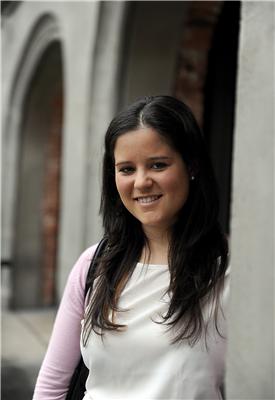Jan 22 2013
Attention Deficit Hyperactivity Disorder (ADHD) is the most common childhood neuropsychiatric disorder. Yet there is currently no tool that will confirm the diagnosis of ADHD. In her thesis entitled “Development of a genotyping system to be applied in Attention Deficit Hyperactivity Disorder and its Pharmacogenetics" (“Desarrollo de un sistema de genotipado para la aplicación en el ‘trastorno por déficit de atención con hiperactividad’ y su farmacogenética”), the researcher Alaitz Molano, a graduate in biochemistry and PhD holder in Pharmacology from the UPV/EHU-University of the Basque Country, presents a tool that could improve not only the diagnosis of but also the therapeutics for this disorder.
 Araitz Molano-Bilbao, the author of the thesis, has a degree in Biochemistry and a PhD in Pharmacology from the UPV/EHU
Araitz Molano-Bilbao, the author of the thesis, has a degree in Biochemistry and a PhD in Pharmacology from the UPV/EHU
The prevalence of ADHD is between 8% and 12% among the infant-adolescent population worldwide, and 50% continue with the symptoms into adult life. Children with ADHD have difficulty paying attention, do not complete the tasks they have been assigned and are frequently distracted. They may also display impulsive behaviour and excessive, inappropriate activity in the context they find themselves in, and experience great difficulty restraining their impulses. “All these symptoms seriously affect the social, academic and working life of the individuals, and impact greatly upon their families and milieu close to them,” says Molano.
In view of the problems existing in diagnosing ADHD patients and deciding about their treatment, this PhD thesis set out to develop and clinically validate a genotyping tool that could help to confirm the diagnosis, to predict how it will evolve, and to select the most suitable pharmacological treatment in each case.
Molano studied how genetic polymorphisms (variations in the DNA sequence between different individuals) are associated with ADHD. “We looked for all the associations that had been described previously in the literature worldwide, and did a clinical study to see whether these polymorphisms also occurred in the Spanish population; the reason is that genetic associations vary a lot between some populations and others."
About 400 saliva samples of patients with ADHD and a further 400 samples from healthy controls without a history of psychiatric diseases were analysed. And the use of over 250 polymorphisms led to the discovery of 32 polymorphisms associated not only with the diagnosis of ADHD but also with the evolution of the disorder, with the ADHD subtype, the symptomatological severity and the presence of comorbidities.
On the basis of these results, Molano is proposing a DNA chip with these 32 polymorphisms, which could be updated with new polymorphisms, as a tool not only for diagnosing but also for calculating genetic susceptibility to different variables (responding well to drugs, normalisation of symptoms, etc.).
The study has also confirmed the existence of the 3 ADHD subtypes: lack of attention, hyperactivity, and a combination. “It can be seen that on the basis of genetics the children that belong to one subtype or another are different,” explains Molano.
By contrast, no direct associations were found between the polymorphisms analysed and the response to pharmacological treatment (atomoxetine and methylphenidate). Molano believes that this could be due to the fact that “in many cases the data on drugs we had available were not rigorous,” due to the difficulty in collecting data of this kind. Molano will in fact be pursuing her research along this line: “We want to concentrate on the drug response aspect, obtain more, better characterised samples, and monitor the variables in the taking of drugs very closely, whether they were actually being taken or not, etc."
Molano hopes that this tool will reach the clinics: “The project was funded by Progenika Biopharma and the pharmaceutical company JUSTE SAFQ, but we also have another 10 collaborating clinics belonging to public and private centres in Spain, and it’s tricky getting them all to agree on matters like patents, marketing, etc. But our idea is that it should eventually be marketed and be welcomed.”